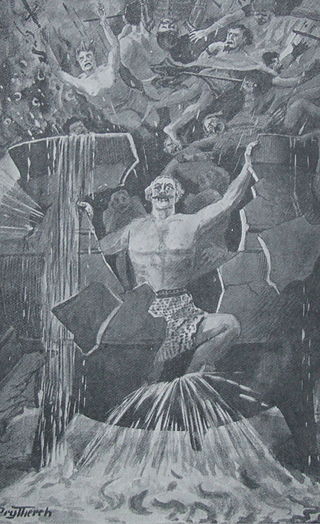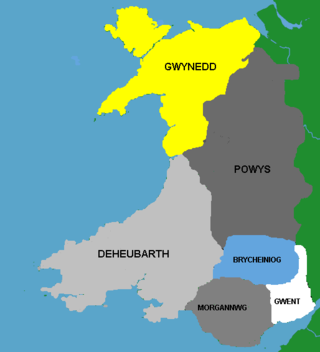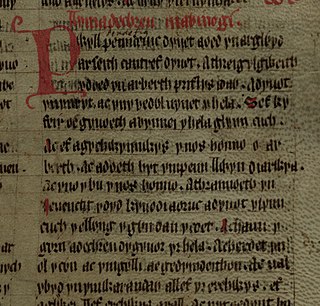Related Research Articles
Manawydan fab Llŷr is a figure of Welsh mythology, the son of Llŷr and the brother of Brân the Blessed and Brânwen. The first element in his name is cognate with the stem of the name of the Irish sea god Manannán mac Lir, and likely originated from the same Celtic deity as Manannán. Unlike Manannán, however, no surviving material connects him with the sea in any way except for his patronymic. Manawydan's most important appearances occur in the Second and Third Branches of the Mabinogi, but he is also referenced frequently in medieval poetry and the Welsh Triads.

Gwydion fab Dôn is a magician, hero and trickster of Welsh mythology, appearing most prominently in the Fourth Branch of the Mabinogi, which focuses largely on his relationship with his young nephew, Lleu Llaw Gyffes. He also appears prominently in the Welsh Triads, the Book of Taliesin and the Stanzas of the Graves.

Pryderi fab Pwyll is a prominent figure in Welsh mythology, the son of Pwyll and Rhiannon, and king of Dyfed after his father's death. He is the only character to appear in all Four Branches of the Mabinogi, although the size of his role varies from tale to tale. He is often equated with the divine son figure of Mabon ap Modron, while Jeffrey Gantz compares him to Peredur fab Efrawg, who is himself associated with the continental figure of Sir Percival de Galles.
Lleu Llaw Gyffes is a hero of Welsh mythology. He appears most prominently in the Fourth Branch of the Mabinogi, the tale of Math fab Mathonwy, which tells the tale of his birth, his marriage, his death, his resurrection and his accession to the throne of Gwynedd. He is a warrior and magician, invariably associated with his uncle Gwydion.
In Welsh mythology, Arawn was the king of the otherworld realm of Annwn who appears prominently in the first branch of the Mabinogi, and alluded to in the fourth. In later tradition, the role of the king of Annwn was largely attributed to the Welsh psychopomp, Gwyn ap Nudd - meaning "white" a possible kenning for his true name. However, Arawn's memory is retained in a traditional saying found in an old Cardigan folktale:

Rhiannon is a major figure in Welsh mythology, appearing in the First Branch of the Mabinogi, and again in the Third Branch. Ronald Hutton called her "one of the great female personalities in World literature", adding that "there is in fact, nobody quite like her in previous human literature". In the Mabinogi, Rhiannon is a strong-minded Otherworld woman, who chooses Pwyll, prince of Dyfed, as her consort, in preference to another man to whom she has already been betrothed. She is intelligent, politically strategic, beautiful, and famed for her wealth and generosity. With Pwyll she has a son, the hero Pryderi, who later inherits the lordship of Dyfed. She endures tragedy when her newborn child is abducted, and she is accused of infanticide. As a widow she marries Manawydan of the British royal family, and has further adventures involving enchantments.
In Welsh tradition, Teyrnon Twryf Lliant is the lord of the Kingdom of Gwent and the foster father of the divine son, Pryderi. He appears most prominently in Pwyll Pendefig Dyfed, the first of the Four Branches of the Mabinogi, but also features briefly in the early tale on the Matter of Britain, Culhwch and Olwen, as a knight of King Arthur. The name Teyrnon is widely acknowledged as deriving from the Common Brittonic *tigernonos, "great lord".
Modron ("mother") is a figure in Welsh tradition, known as the mother of the hero Mabon ap Modron. Both characters may have derived from earlier divine figures, in her case the Gaulish goddess Matrona. She may have been a prototype for Morgan le Fay from the Arthurian legend.

Efnisien fab Euroswydd is a sadistic anti-hero in Welsh mythology, appearing prominently in the tale of Branwen ferch Llŷr, the second branch of the Mabinogi. Described by Will Parker as "a study in the psychopathic personality" and an "embodiment of the forces of anti-social disruption," he is the catalyst of the tale's ultimate tragedy, and is largely responsible for the destruction of both Ireland and the Island of the Mighty. He is the son of Euroswydd and Penarddun, twin brother to Nisien, and half-brother to Brân the Blessed, Manawydan, and Branwen. The Welsh Triads call Llŷr one of the Three Exalted Prisoners of Britain for his captivity at Euroswydd's hands; this is likely to a lost tradition of the birth of Penarddun's younger sons.
Gwern is a minor figure in Welsh tradition. He is the son of Matholwch, king of Ireland, and Branwen, sister to the king of Britain. He appears in the tale of Branwen, daughter of Llŷr, in which his murder at the hands of his sadistic uncle Efnysien sparks a mutually destructive battle between Britain and Ireland.

Brân the Blessed is a giant and king of Britain in Welsh mythology. He appears in several of the Welsh Triads, but his most significant role is in the Second Branch of the Mabinogi, Branwen ferch Llŷr. He is a son of Llŷr and Penarddun, and the brother of Brânwen, Manawydan, Nisien and Efnysien. The name "Brân" in Welsh is usually translated as crow or raven.

The Mabinogion are the earliest Welsh prose stories, and belong to the Matter of Britain. The stories were compiled in Middle Welsh in the 12th–13th centuries from earlier oral traditions. There are two main source manuscripts, created c. 1350–1410, as well as a few earlier fragments. The title covers a collection of eleven prose stories of widely different types, offering drama, philosophy, romance, tragedy, fantasy and humour, and created by various narrators over time. There is a classic hero quest, "Culhwch and Olwen"; a historic legend in "Lludd and Llefelys", complete with glimpses of a far off age; and other tales portray a very different King Arthur from the later popular versions. The highly sophisticated complexity of the Four Branches of the Mabinogi defies categorisation. The stories are so diverse that it has been argued that they are not even a true collection.

Welsh mythology consists of both folk traditions developed in Wales, and traditions developed by the Celtic Britons elsewhere before the end of the first millennium. As in most of the predominantly oral societies Celtic mythology and history were recorded orally by specialists such as druids. This oral record has been lost or altered as a result of outside contact and invasion over the years. Much of this altered mythology and history is preserved in medieval Welsh manuscripts, which include the Red Book of Hergest, the White Book of Rhydderch, the Book of Aneirin and the Book of Taliesin. Other works connected to Welsh mythology include the ninth-century Latin historical compilation Historia Brittonum and Geoffrey of Monmouth's twelfth-century Latin chronicle Historia Regum Britanniae, as well as later folklore, such as the materials collected in The Welsh Fairy Book by William Jenkyn Thomas (1908).
The Four Branches of the Mabinogi or Pedair Cainc Y Mabinogi are the earliest prose stories in the literature of Britain. Originally written in Wales in Middle Welsh, but widely available in translations, the Mabinogi is generally agreed to be a single work in four parts, or "branches." The interrelated tales can be read as mythology, political themes, romances, or magical fantasies. They appeal to a wide range of readers, from young children to the most sophisticated adult. The tales are popular today in book format, as storytelling or theatre performances; they appear in recordings and on film, and continue to inspire many reinterpretations in artwork and modern fiction.
Llwyd ap Cil Coed is a character in the Third Branch of The Mabinogi, known also as the story of Manawydan ap Llŷr.
Caradog ap Bran is the son of the British king Bran the Blessed in Welsh mythology and literature, who appears most prominently in the second branch of the Mabinogi, the tale of Branwen ferch Llŷr. He is further mentioned in the Welsh Triads and in certain medieval Welsh genealogies. Caradog is the grandson of the sea god Llŷr, the nephew of Manawydan, Branwen, Efnisien and Nisien.

Glywys is a legendary early 5th century Welsh king, an important character in early Welsh genealogies as the eponymous founder king of Glywysing, a southeast Welsh kingdom whose heartland lay between the Tawe and the Usk.

Pwyll Pendefig Dyfed, "Pwyll, Prince of Dyfed," is a legendary tale from medieval Welsh literature and the first of the Four Branches of the Mabinogi. It tells of the friendship between Pwyll, prince of Dyfed, and Arawn, lord of Annwn, of the courting and marriage of Pwyll and Rhiannon and of the birth and disappearance of Pryderi. This branch introduces a number of storylines that reappear in later tales, including the alliance between Dyfed and Annwn, and the enmity between Pwyll and Gwawl. Along with the other branches, the tale can be found in the medieval Red Book of Hergest and White Book of Rhydderch.

Branwen ferch Llŷr; "Branwen, daughter of Llŷr" is a legendary tale from medieval Welsh literature and the second of the four branches of the Mabinogi. It concerns the children of Llŷr; Bendigeidfran, high king of Britain, and his siblings Manawydan and Branwen, and deals with the latter's marriage to Matholwch, king of Ireland. Matholwch's mistreatment of the British princess leads to a mutually destructive war between the two islands, the deaths of most of the principal characters, and the ascension of Caswallon fab Beli to the British throne. Along with the other branches, the tale can be found in the medieval Red Book of Hergest and White Book of Rhydderch. It is followed directly by the third branch, Manawydan fab Llŷr.

Manawydan fab Llŷr; "Manawydan, the son of Llŷr" is a legendary tale from medieval Welsh literature and the third of the four branches of the Mabinogi. It is a direct sequel to the second branch, Branwen ferch Llŷr, and deals with the aftermath of Bran's invasion of Ireland and the horrific enchantment that transforms Dyfed into a wasteland. The chief characters of the tale are Manawydan, rightful king of Britain, his friend Pryderi, the king of Dyfed and their respective wives Rhiannon and Cigfa. Along with the other branches, the tale can be found the medieval Red Book of Hergest and White Book of Rhydderch. Allusions to the tale can be found in two old triads retained in the Trioedd Ynys Prydein.